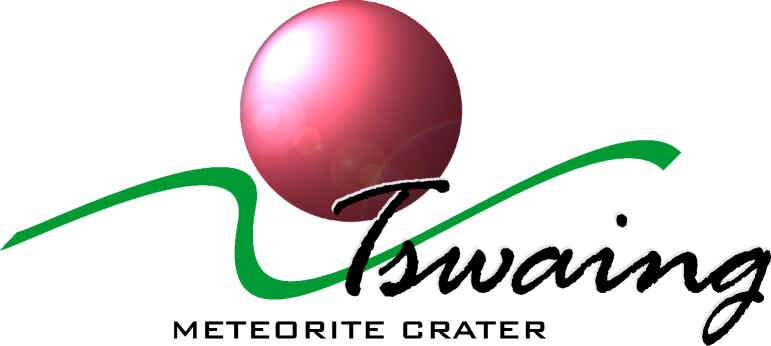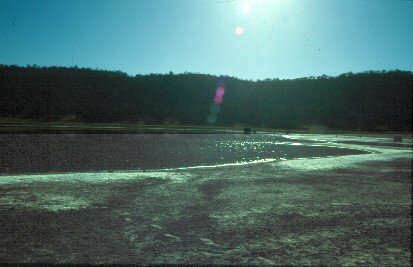|
The 60-ton Hoba iron meteorite at Grootfontein, Namibia (courtesy Department of Geology, University of the Witwatersrand) |
 |
|
Meteorites: Messengers From Space |
|
| On a clear night one only has to watch an area of the sky for a few minutes, before some bright streaks or trails of light can be detected. These appearances are meteors, also known as shooting stars, caused by the passage through and burn-up of a small chunk of extraterrestrial matter in the Earth's atmosphere. While this object is in space, it is called a meteoroid. Should it, however, survive the passage through the atmosphere, it will be called a meteorite or, if it is very small, a micrometeorite. Micrometeorites are cosmic spherules and interplanetary dust particles. While they are extremely small individually, the total mass of meteoritic material that lands on the Earth's surface each year is more than 10 000 tonnes. Meteorites are somewhat larger objects, generally weighing between several grams and several kilograms. Friction in the atmosphere generates enormous heat, which may lead to the vaporisation of some, often all, of the material of a meteor. Other bodies may break up, and small pieces that are not burned up may make it to the ground. The largest known meteorite is the 60-tonne Hoba iron meteorite in northern Namibia. There are a number of types of meteorites: stony, stony-iron and iron meteorites. The stony meteorites are by far the most abundant type, as 90% of all meteorites collected are of this type. It is believed that it was a stony meteorite that made the Tswaing Crater. They consist of minerals that contain a lot of the element silicon, as do the rocks on Earth. In addition, they contain some metal, mostly composed of iron and nickel. When this component becomes very abundant, the meteorite is called a stony-iron meteorite. Iron meteorites are basically composed of metal, with perhaps a few percent of silicate materials. Meteorites come from parent bodies, asteroid-size bodies that have been broken up, probably because of a collision with another body. It is thought that some parent bodies of specific meteorite classes have been identified in the asteroid belt between Mars and Jupiter. With the exception of a few samples returned by astronauts and unmanned space probes from the Moon, meteorites are the only source of information about other extraterrestrial bodies, namely their parent bodies, in the Solar System. In comparison with the gigantic costs of space-sampling programmes, they also provide a cheap source of information and one that conveniently comes to us. Some meteorite types represent material that is as old as the Solar System itself (4 560 000 000 years) or even contain traces of pre-Solar material. Thus, from the study of the minerals and the chemistry of these meteorites we can learn about the earliest stages of the evolution of the Solar System, as well as subsequent events that affected these rocks. There are numerous meteoroids in space, but there are also much larger objects that may enter the Earth's atmosphere and that potentially could pose a major threat to the Earth and its inhabitants. Asteroids are a group of relatively small planetary bodies, also known as minor planets or planetoids. They are thought to be left-overs from the formation phase of planets, and/or the debris from the break-up of disintegrated planetary bodies. Asteroids are mostly in orbit around the Sun, and primarily between Jupiter and Mars in the so-called asteroid belt. The orbits of some 5 000 asteroids have been tracked. Most of them are not remotely on a collision course with Earth, but there are two groups of asteroids (the Apollo and Aten objects), which are known as the Near-Earth Objects (NEOs) and which could cross the earth's orbit. Some 200 of these have been identified but it is thought that this number represents only one tenth of the total NEO population. The sizes of asteroids range from just a few metres to nearly a thousand kilometres. Asteroids are of great interest to scientists who want to learn more about the Solar System, or about the potentially lethal effects of asteroid impact. These rocky planets could also, sometime, become beneficial to humanity, as they contain a host of valuable elements and minerals. They could provide important resources for settling in space and as such are of great interest to NASA. Besides meteoroids and asteroids, the third group of objects that might collide with Earth are comets. Comets are fluffy bodies, composed of mixtures of solid and volatile matter, such as ice of various compounds, including water, carbon monoxide and carbon dioxide. Comets possess a nucleus and a tail. The tail of a comet is composed of vaporised and ionised gases that are blown off the nucleus. Comets may reach considerable sizes, so that they could represent significant impact projectiles. They have highly variable orbits, which are subject to changes because of disturbances by gravity fields of large planets. In our Solar System, the planet with the largest mass, and thus gravitational attraction, is Jupiter. In addition, the uncertainty about their ultimate orbits makes it very difficult to predict when which comet might enter an orbit that could take it too close to a planet, such as Earth. |
|
| (Source: REIMOLD, W U, BRANDT, D, DE JONG, R C, HANCOX, J, 1999, Tswaing Meteorite Crater. An introduction to the natural and cultural history of the Tswaing region including a description of the hiking trail. Popular Geoscience Series 1. Pretoria: Council for Geoscience. Available at the Council for Geoscience, Pretoria, South Africa) | |
| All intellectual property rights, including but not limited to copyright and trademarks, vested in the material contained on the NFI website is held by the NFI and may not be copied, reproduced, adapted, published or distributed in any form whatsoever without the prior written consent of the responsible person at the NFI. | |
